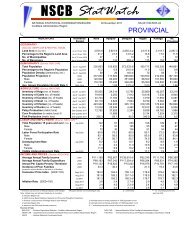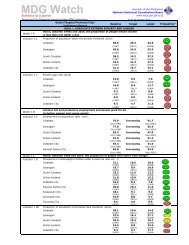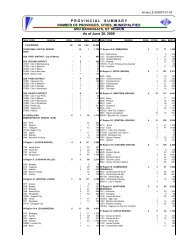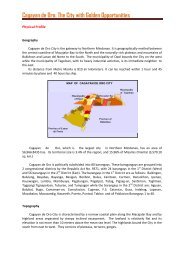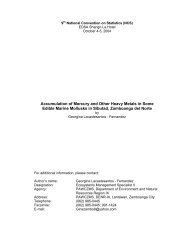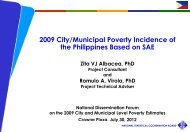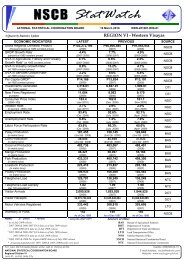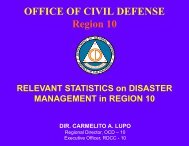chapter 6 development of the subnational statistical system - NSCB
chapter 6 development of the subnational statistical system - NSCB
chapter 6 development of the subnational statistical system - NSCB
- No tags were found...
Create successful ePaper yourself
Turn your PDF publications into a flip-book with our unique Google optimized e-Paper software.
Philippine Statistical Development Program, 2005-2010emergency situation I.e. food shortages due to bombing <strong>of</strong> utilities, (e.g. airport and bus terminal) ando<strong>the</strong>r peace and order problems.In some areas, only benchmark data from old censuses or special surveys are available. Likewise,problems on aggregation and data sharing among provincial, city and municipal LGUs due to lack <strong>of</strong>standardized data base at <strong>the</strong> LGU level and lack <strong>of</strong> IT related skills also hamper <strong>the</strong> generation <strong>of</strong>necessary information at <strong>the</strong> local level. Data from administrative records are not yet fully exploited dueto lack <strong>of</strong> manpower resources and IT equipment to be used for processing. Statistics on agriculture,fisheries, forestry and solid waste management are not available at <strong>the</strong> city/municipal level. O<strong>the</strong>r datagaps identified at <strong>the</strong> local level deal with priority concerns such as income, housing, finance,investment, wages and compensation. Data processing and dissemination <strong>of</strong> some sectoral and vitalstatistics remain centralized. These deficiencies underscore <strong>the</strong> need for fur<strong>the</strong>r advocacy todecentralize <strong>the</strong> processing and dissemination <strong>of</strong> data at <strong>the</strong> local levels toge<strong>the</strong>r with <strong>the</strong>standardization <strong>of</strong> data collection and compilation <strong>of</strong> local statistics among LGUs to reduce <strong>the</strong> time lag<strong>of</strong> release and make <strong>the</strong>se information accessible to local planners.Data gaps in <strong>the</strong> generation <strong>of</strong> <strong>the</strong> regional and provincial accountsRegional accounts are still being compiled by <strong>the</strong> <strong>NSCB</strong> through its Economic Statistics Office (ESO)with assistance from <strong>the</strong> <strong>NSCB</strong> regional divisions which are present only in ten regions <strong>of</strong> <strong>the</strong> country.Since <strong>the</strong>se accounts are designed to measure <strong>the</strong> economic performance <strong>of</strong> <strong>the</strong> region, <strong>the</strong> clamor for<strong>the</strong>se accounts to be compiled at <strong>the</strong> regional level increased and points to <strong>the</strong> need to transfer <strong>the</strong>estimation to <strong>the</strong> <strong>NSCB</strong> regional divisions. This merits fur<strong>the</strong>r study considering <strong>the</strong> absence <strong>of</strong> an<strong>NSCB</strong> regional unit in <strong>the</strong> seven remaining regions which would meet <strong>the</strong> needs <strong>of</strong> <strong>the</strong> regional incomeaccounts and o<strong>the</strong>r existing data gaps at <strong>the</strong> regional and subregional levels.With <strong>the</strong> devolution <strong>of</strong> powers and functions to <strong>the</strong> local government units, <strong>the</strong> regions are no longerpolitical nor administrative units. Thus, local planning and programming <strong>of</strong> funds now rest on <strong>the</strong>provincial and municipal government units. In view <strong>of</strong> <strong>the</strong>se <strong>development</strong>s, <strong>the</strong> clamor for <strong>the</strong>generation <strong>of</strong> <strong>the</strong> provincial accounts had increased.Inadequate financial resourcesThe inadequacy <strong>of</strong> resources for undertaking <strong>statistical</strong> activities, such as data collection/improvement,<strong>statistical</strong> R & D, institution building/enhancement and <strong>statistical</strong> manpower <strong>development</strong>, is more felt at<strong>the</strong> <strong>subnational</strong> level. Considering <strong>the</strong> expected increase in <strong>development</strong> activities in <strong>the</strong> regions due todecentralization, financial resources being channeled to <strong>the</strong> regions need to be augmented to enable<strong>the</strong> SSS to provide <strong>the</strong> required information support to <strong>the</strong> planning, programming and budgetingfunctions <strong>of</strong> <strong>the</strong> local executives. Weak IT capabilities due to lack/unavailability <strong>of</strong> hardware ands<strong>of</strong>tware for data processing, storage and dissemination.Inadequate <strong>statistical</strong> manpower complement and <strong>the</strong> need for career <strong>system</strong> and manpower<strong>development</strong> programDecentralization entails greater involvement <strong>of</strong> regional/local <strong>statistical</strong> personnel in <strong>the</strong> collection,processing and dissemination <strong>of</strong> data for planning, policy-formulation and decision-making. However,due to <strong>the</strong> low compensation scheme, pr<strong>of</strong>essional statisticians have been deterred from pursuing <strong>the</strong>ircareer in <strong>the</strong> government particularly in <strong>the</strong> regions. This problem has contributed greatly to a fastturnover rate among regional <strong>statistical</strong> workers. As a result, non-statisticians do <strong>statistical</strong> work in someagencies in <strong>the</strong> region and at <strong>the</strong> local level. Thus, <strong>the</strong> <strong>subnational</strong> <strong>statistical</strong> <strong>system</strong> has long been inneed <strong>of</strong> adequate and continuous supply <strong>of</strong> <strong>statistical</strong> manpower.In view <strong>of</strong> <strong>the</strong>se <strong>development</strong>s, it is important to undertake special programs for <strong>the</strong> <strong>development</strong> andacquisition as well as retention <strong>of</strong> <strong>the</strong> needed skills at <strong>the</strong> local level. It is also necessary to continuouslyupgrade <strong>the</strong> quality <strong>of</strong> existing <strong>statistical</strong> manpower at <strong>the</strong> <strong>subnational</strong> level. This situation calls for <strong>the</strong>setting-up <strong>of</strong> a career <strong>system</strong> for statisticians in government and <strong>the</strong> formulation and implementation <strong>of</strong>a responsive and comprehensive <strong>statistical</strong> manpower <strong>development</strong> program.III. STATISTICAL DEVELOPMENT PROGRAM, 2005-2010For <strong>the</strong> Plan period 2005-2010, local <strong>statistical</strong> <strong>development</strong> efforts will be geared towards measuring<strong>the</strong> implementation <strong>of</strong> <strong>the</strong> Medium Term Development Plan 2005 to 2010, <strong>the</strong> Ten Point Agenda at <strong>the</strong>Development <strong>of</strong> <strong>the</strong> Subnational Statistical System 6-11



